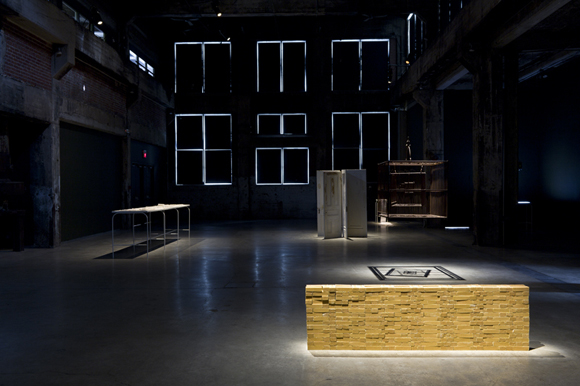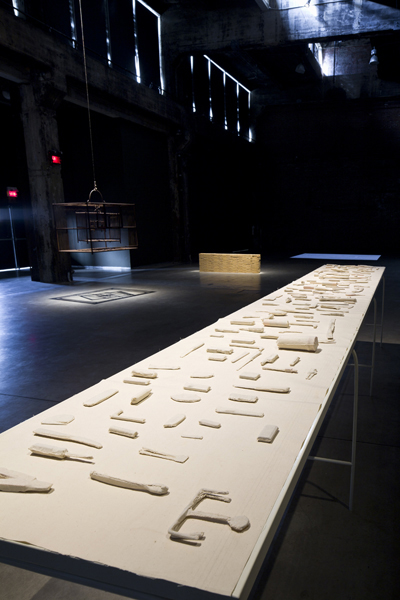Currently on view: Montréal
Shilpa Gupta: Will we ever be able to mark enough?
at Darling Foundry
5 October – 4 December 2011 (extended)
Curator: Renée Baert

Shilpa Gupta “Will we ever be able to mark enough?” Installation view at Darling Foundry 2011. Courtesy of the artist and Darling Foundry. Photo credit: Guy L’Heureux
In a rapidly globalizing world, intensified human migrations have brought issues of identity, culture and homeland to the forefront of many’s political agenda, and with them the fears and insecurities of change. Shilpa Gupta’s exhibition Will we ever be able to mark enough? at Darling Foundry sharply addresses some of our most recurrent anxieties for the issues above, particularly regarding border security. The Mumbai artist worked in collaboration with Montreal curator Renée Baert to present her first Canadian solo show, a selection of recent pieces as well as pivotal new works, created specifically for this show.
Unfortunately unavailable to personally set up the exhibition, the artist however did invest much fervor in her selection of signature works. Before even entering the exhibition, a row of six color photographs greet us, hanging on a brick wall across the street from the Foundry. All one and a half meters in diameter, each square image captures the upper body movements of dark skinned figures, arms flailing and faces blurred by slow shutter photo effects. In stepping outside the institutional space of the gallery, Gupta continues her ongoing practice of confronting her images in public settings, usually reserved for advertising purposes. As opposed to the latter’s focus on instantaneous communications, Gupta draws a more complex worldview.

Shilpa Gupta “Will we ever be able to mark enough?” Installation view at Darling Foundry 2011. Courtesy of the artist and Darling Foundry. Photo credit: Guy L’Heureux
Now within the pitch black area of the main gallery, intermittent spotlights direct our view of each showcased work. The video installation “A map of my country†(2011) reiterates Gupta’s tendency to include audience participation. This Darling Foundry special commission started out as a collection of scribbles, collected throughout last summer. Random passers-by near the gallery were handed paper and pencils, and kindly asked to draw a map of their home country. The resulting shapes varied widely from familiar geographies to semi-organic blobs, even when sometimes designating the same place. Does this reveal the mutability of our personal experiences of homeland, or more simply, the inconsistencies of individual drawing skills? Gupta leaves this question open, but hints at an answer in beaming the scanned country outlines one after another in a continuous video loop, from the transcendent light coming down of an overhanging projector, onto the top of a plain metal school desk.
The artist’s other works on display create visual metaphors that remain simple in composition, while encompassing a rich variety of associations. “Untitled†(2011) for example consists of seven banged up, handle-less, chipped painted white doors. The latter are all hinged together to create a star shape, fanning out in a never-ending circle of entries and exits. Perhaps one could find here a far-fetched likeness to Duchamp’s 11 Rue Larrey (1927) which articulates a door in between two openings, forever leaving it both opened and closed. Would it be safer to assume Gupta is instead criticizing some countries’ revolving-door immigration policy? Similarly, “Threat†(2008-2009) builds a low wall with one hundred light brown bars of soap, each stamped with the word ‘THREAT’. Again questions come flowing in: will this wall block or simply wash away a dirty invader? Another “Untitled†(2010) sees three metal cages hang from the ceiling, each suspended inside a bigger one, like set of Russian dolls. Each trapped in an abyss of self-imprisonment, could the cages represent evermore restricting definitions of homeland?

Front image: “There Is No Explosive in This” (2011) installation view. Courtesy of the artist and
Darling Foundry. Photo credit: Guy L’Heureux
For what is arguably the centerpiece of the show, “There Is No Explosive in This†(2011), curator Baert recovered nearly 200 confiscated carry-on items from Pierre Elliot Trudeau International Airport and, with untold logistical difficulties, shipped these via Fed Ex to Mumbai, for Gupta to process. She thus stitched a selection of scissors, hammers, pliers, knives and handcuffs into form-fitting brown cloth envelops before sending them back again to Montreal. Now systematically laid out in the gallery on a long table also covered in brown cloth, the once judged dangerous items have become mere shadows of themselves, nearly indistinguishable from the background covered in the same material. Once more it seems up to the viewer to decide, whether this work is offering lessons in effective smuggling or rather to provide a new state of innocence for the lost items.
The limitations outlining each citizen’s corporeal movements and political identity are everywhere around us, marked out through maps, laws and policies. Will we ever be able to mark enough? draws to our attention a non-western way of seeing how we inhabit these marks, how these orientate our perceptions and feed our fears, especially when it comes to contested territories. With this in mind, Gupta effectively has encircled the tensions that first appear local but inevitably reveal themselves as global. But then one wonders, have we already marked too much?
Text by Yaniya Lee
Shilpa Gupta’s website: www.flyinthe.net
Darling Foundry
745 Ottawa street
Montreal, QC
H3C 1R8 Canada
514.392.1554
info@fonderiedarling.org
www.fonderiedarling.org
Opening hours: Wednesday to Sunday 12 – 7 pm,
Thursday until 10 pm.
* Presentation by curator on Thursday 1 December 2011 at 6pm
